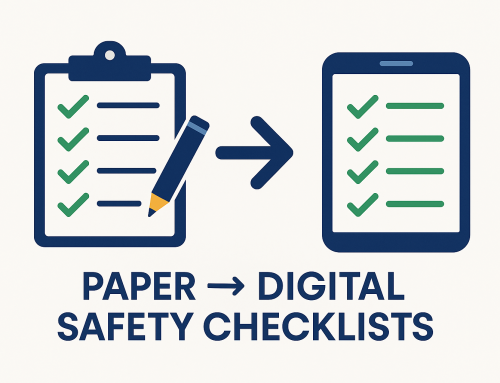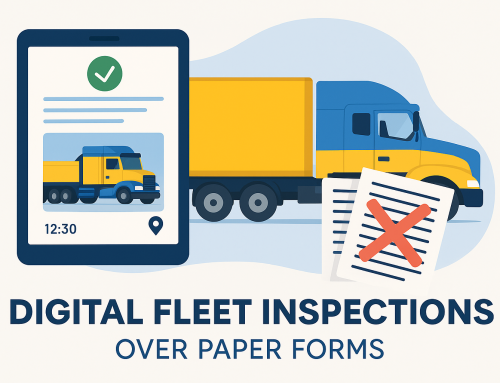Forklift operator using a digital checklist for pre-start inspection. Stay safe, stay compliant.
Forklift Pre-Start Safety Checks: Boost Compliance & Safety
Forklifts are the backbone of warehouses, logistics hubs, and worksites — but without proper forklift pre-start safety checks, they can quickly turn from productivity machines into safety hazards. Regular inspections prevent costly breakdowns, reduce downtime, and ensure compliance with Safe Work Australia’s forklift guidance. In this guide, we cover what to check (including compliance plates and seatbelts), why it matters, and how DIGI CLIP digital checklists make inspections fast and audit-ready.
- Daily forklift checks reduce breakdowns and prevent incidents.
- Essential for WHS compliance and Safe Work Australia expectations.
- Digital checklists capture photos, signatures, and geo-time stamps.
- Automatic corrective actions via DIGI CLIP’s Action Register.
- Improves uptime, audit readiness, and operator accountability.
Why Forklift Pre-Start Safety Checks Matter
Every forklift carries risk — tip-overs, load failures, brake issues, poor visibility. Systematic forklift pre-start safety checks ensure critical systems work before use and create a defensible record for audits and incident investigations. Benefits include:
- Preventing accidents and injuries
- Meeting WHS duties and aligning with ISO 45001 principles
- Reducing costly downtime and unplanned maintenance
- Creating transparent, audit-ready inspection evidence
- Driving operator awareness and accountability
Key Items to Inspect in a Forklift Pre-Start Checklist
A robust checklist covers mechanical, safety, and compliance-critical areas. Core items include:
- Tyres and wheels (damage, inflation, wear)
- Brakes, steering, and horn
- Lights, warning devices, and reverse beepers
- Mast, chains, hydraulics, and tilt/lift controls
- Load backrest extension and forks (straight, no cracks or distortion)
- Compliance plates and load rating plates (present, legible, not obscured)
- Seatbelts and operator restraints (functioning, latches lock/release, webbing undamaged)
- Battery or fuel levels, gas connections (secure, no leaks)
- Fire extinguisher (charged, tagged, accessible)
- Decals, safety labels, and operator manual storage (present and legible)
Digital vs Paper Forklift Checklists
| Paper Checklists | Digital Checklists (DIGI CLIP) |
|---|---|
| Prone to damage, loss, or illegible handwriting | Secure cloud storage with durable, searchable records |
| Slow to file; hard to track across shifts and sites | Instant submission with time, date, and location stamps |
| No automated alerts for failed checks | Automatic Action Register notifications and assignments |
| Limited audit trail and poor evidence capture | Photos, signatures, and change history for audit readiness |
| Manual data entry for reporting and trend analysis | One-click exports and analytics for trends and close-outs |
Digital checklists deliver speed, evidence, and accountability — crucial for WHS compliance and operational uptime.
How DIGI CLIP Streamlines Forklift Safety
DIGI CLIP transforms forklift pre-start safety checks into real-time, verifiable records. Operators complete inspections on mobile, supervisors receive instant alerts, and actions are tracked to close-out. Features include:
- Photo capture of faults and defects
- Geo-time stamping for accountability
- Automated alerts for failed items
- Centralised Action Register to manage corrective actions
- Audit-ready reporting in a few clicks
Related reading
- Digital checklists for workplace safety
- Top benefits of digital inspection apps for compliance
- From paper to digital: compliance tools for SMBs
About DIGI CLIP Mobile Forms
DIGI CLIP is a mobile checklist and inspection app that simplifies safety, compliance, and operational reporting for transport, warehousing, agriculture, construction, and more. It replaces paper forms with real-time digital checklists.
With built-in photo capture, automated alerts, geo-time stamping, and an Action Register, DIGI CLIP ensures nothing gets missed. Because safety actions don’t count if you can’t prove them.
Frequently Asked Questions
How often should forklift pre-start safety checks be completed?
At the start of every shift or before each use to comply with WHS and manufacturer guidance.
Are forklift pre-start checks a legal requirement?
Yes, forklift pre-start checks are indeed a legal requirement in Australia. These mandatory safety inspections must be conducted before operating any forklift and are enforced across all Australian states and territories under their respective Work Health and Safety (WHS) legislation.
Do I have to check compliance plates and seatbelts daily?
Yes — compliance plates (including load rating plates) must be present and legible, and seatbelts/operator restraints must lock, release, and be undamaged. Record defects and remove the unit from service until repaired.
Can digital checklists replace paper for compliance audits?
Yes. Digital records provide timestamps, signatures, photos, and an auditable history — far more reliable than paper.
What happens if a fault is found during a pre-start check?
Tag out the forklift and do not use it until repaired. DIGI CLIP logs the issue in the Action Register and tracks close-out.
Conclusion: Forklift Pre-Start Safety Checks Made Simple
Daily forklift pre-start safety checks are non-negotiable for WHS compliance, productivity, and worker safety. With DIGI CLIP’s digital checklists, you capture real-time evidence, automate fault reporting, and stay audit-ready — without the paperwork drag.
If you liked this post? Why not share it!








Leave A Comment